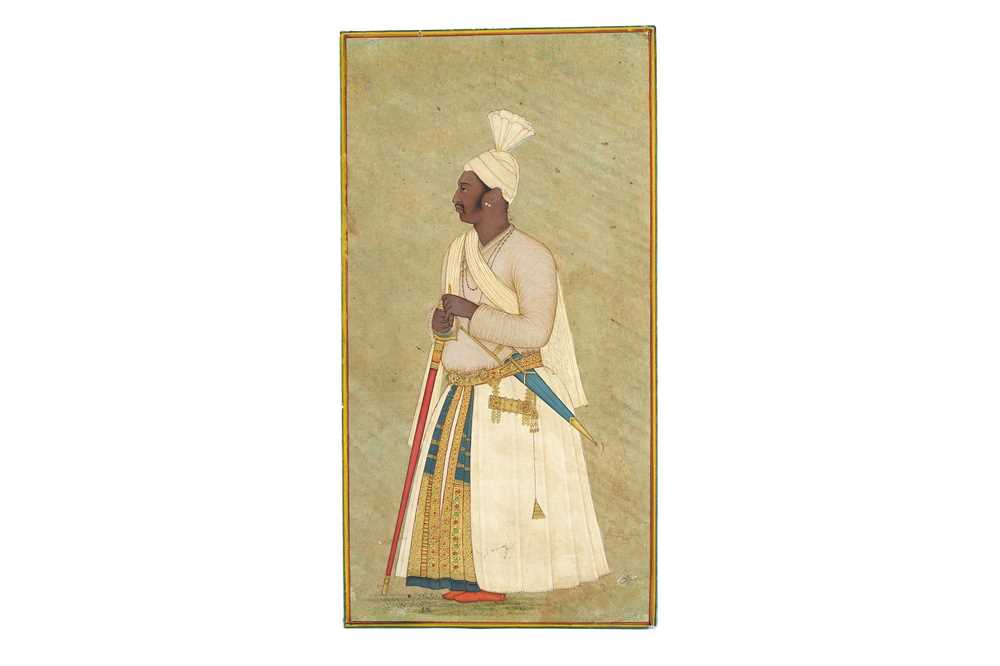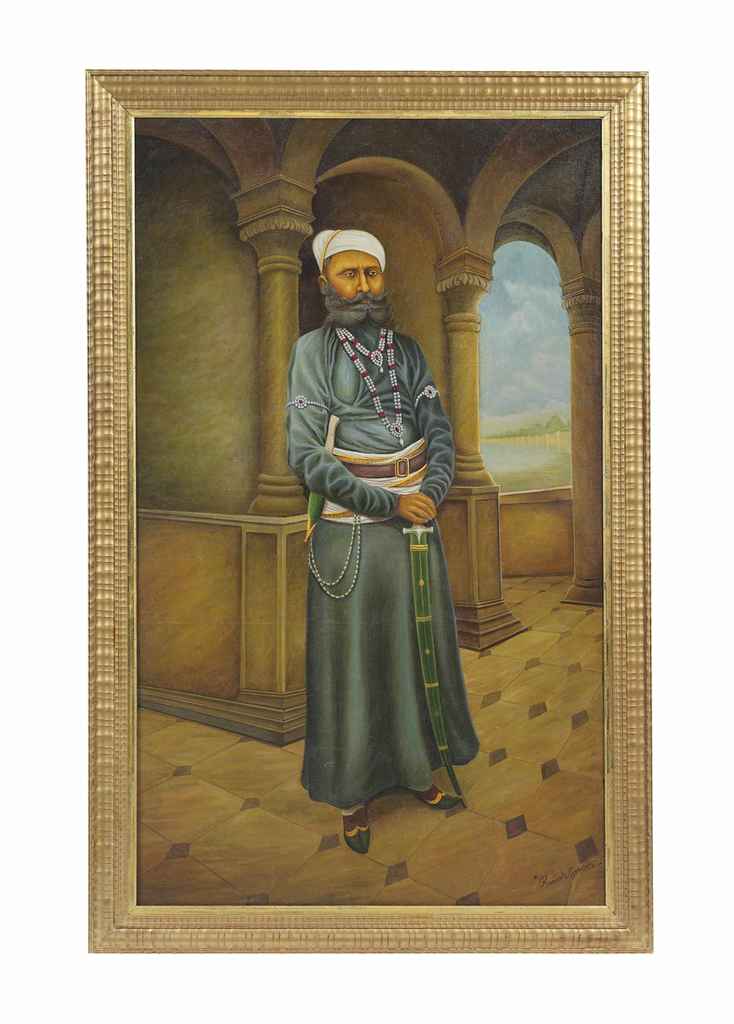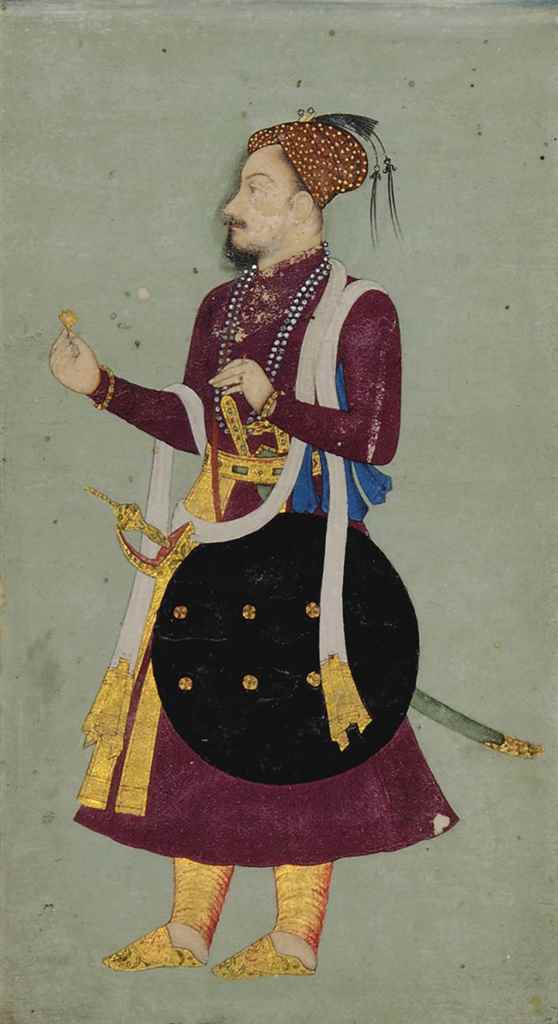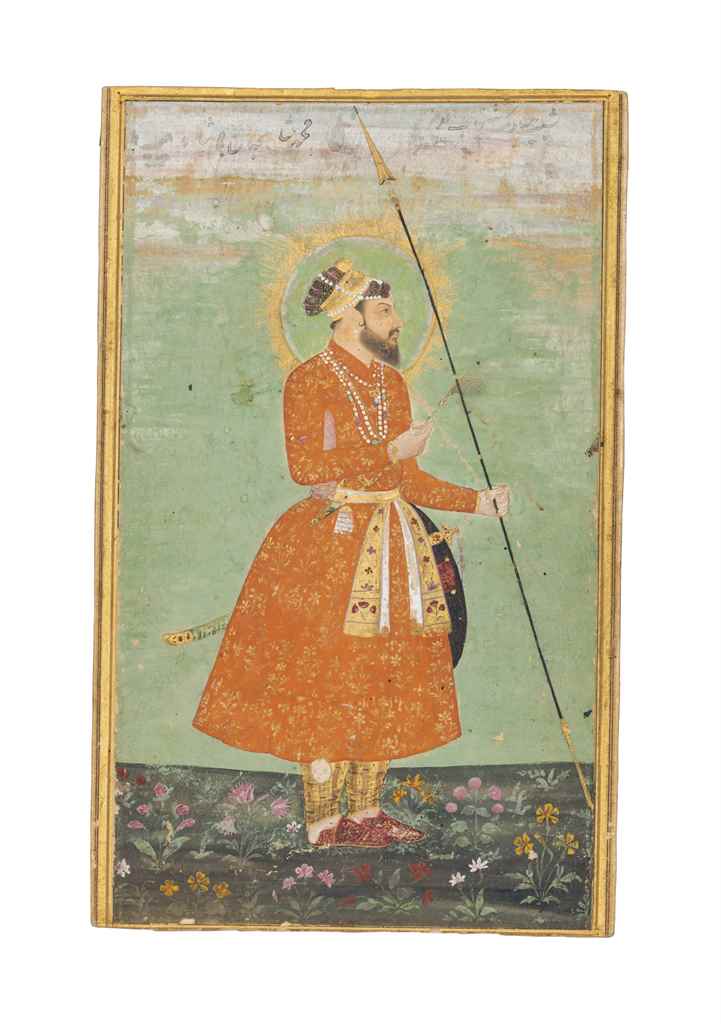(Islamic & Indian Art, 16th April 2021) A STANDING PORTRAIT OF A MUGHAL NOBLEMAN, POSSIBLY THE EMPEROR BABUR Mughal School, Northern India, 18th century A STANDING PORTRAIT OF A MUGHAL NOBLEMAN, POSSIBLY THE EMPEROR BABUR PROPERTY FROM A PRIVATE AMERICAN COLLECTION Mughal School, Northern India, 18th century Opaque pigments, ink and pencil heightened with gold on paper, the vertical portrait depicting a standing Mughal nobleman, possibly a courtier or a prince, wearing a light yellow robe and an embroidered gilt overcoat with floral designs and fur neck, around his waist a golden sash matching the style of his overcoat, with gold-embroidered madder red velvet boots, his overall attire reminiscent of early Mughal portraits of Emperor Babur and noblemen of Central Asian origin wearing similar hunting coats of Persian influence, the portrait set within black and gold rules and concentric decorative borders comprising a band of cusped white cartouches against lapis lazuli blue ground; a band of golden interlocking and spiraling floral tendrils; a band of red dotted motif against pink ground; and a golden vegetal border in the style of Mughal muraqqa' album pages, the recto plain except for numerical notes in pencil and an old inventory sticker no. 359 Hiss, 31.5cm x 20.3cm. Hunting coats similar to the one this nobleman is wearing were incredibly popular at the Mughal court in the 17th and 18th centuries. Usually made of embroidered satin with silk, they were decorated in a variety of stitches with images of flowers, trees, green shrubs, vegetation, and animals like peacocks, lions and deer. Cool palettes with soft hues usually hint at an Iranian influence; with time overcoats produced in India became more and more colourful. One of the finest surviving examples of 17th-century Mughal overcoats is at the Victoria and Albert Museum in London (inv. no. IS-18.1947). A similar coat to the one in our portrait can be admired on a page from the Nasir al-Din Shah Album at the Chester Beatty Library in Dublin, portraying the Emperor Shah Jahan gifting a jewel to Dara Shikoh (inv. no. IN 50.3), published in S. Stronge, Made for Mughal Emperors, 2010, p. 47, pl. 24. The detail of the fur neck is not accidental. Indeed, the first Emperor of the Mughal dynasty, Babur, was often depicted with coats with fur necks, a clear memento of his Central Asian origin, and predilection for the cold weather of the steppes, rather than the humid hot weather of the Subcontinent. A portrait of Babur in the Khalili Collections (MSS 1028) in London, attributed to the North Deccani school, ca. 1695 - 1700, depicts the young Emperor in similar attire to our lot, wearing a gilt overcoat with vegetal motifs and gold-embroidered madder red velvet boots. The example in the Khalili Collections is accompanied by a nasta‘liq inscription on the recto, Sultan Babur, and another in Dutch, Baber (‘Babur’), making the subject of the portrait unequivocal. (Qty: 1) 31.5cm x 20.3cm
(Islamic & Indian Art, 16th April 2021) A STANDING PORTRAIT OF A MUGHAL NOBLEMAN, POSSIBLY THE EMPEROR BABUR Mughal School, Northern India, 18th century A STANDING PORTRAIT OF A MUGHAL NOBLEMAN, POSSIBLY THE EMPEROR BABUR PROPERTY FROM A PRIVATE AMERICAN COLLECTION Mughal School, Northern India, 18th century Opaque pigments, ink and pencil heightened with gold on paper, the vertical portrait depicting a standing Mughal nobleman, possibly a courtier or a prince, wearing a light yellow robe and an embroidered gilt overcoat with floral designs and fur neck, around his waist a golden sash matching the style of his overcoat, with gold-embroidered madder red velvet boots, his overall attire reminiscent of early Mughal portraits of Emperor Babur and noblemen of Central Asian origin wearing similar hunting coats of Persian influence, the portrait set within black and gold rules and concentric decorative borders comprising a band of cusped white cartouches against lapis lazuli blue ground; a band of golden interlocking and spiraling floral tendrils; a band of red dotted motif against pink ground; and a golden vegetal border in the style of Mughal muraqqa' album pages, the recto plain except for numerical notes in pencil and an old inventory sticker no. 359 Hiss, 31.5cm x 20.3cm. Hunting coats similar to the one this nobleman is wearing were incredibly popular at the Mughal court in the 17th and 18th centuries. Usually made of embroidered satin with silk, they were decorated in a variety of stitches with images of flowers, trees, green shrubs, vegetation, and animals like peacocks, lions and deer. Cool palettes with soft hues usually hint at an Iranian influence; with time overcoats produced in India became more and more colourful. One of the finest surviving examples of 17th-century Mughal overcoats is at the Victoria and Albert Museum in London (inv. no. IS-18.1947). A similar coat to the one in our portrait can be admired on a page from the Nasir al-Din Shah Album at the Chester Beatty Library in Dublin, portraying the Emperor Shah Jahan gifting a jewel to Dara Shikoh (inv. no. IN 50.3), published in S. Stronge, Made for Mughal Emperors, 2010, p. 47, pl. 24. The detail of the fur neck is not accidental. Indeed, the first Emperor of the Mughal dynasty, Babur, was often depicted with coats with fur necks, a clear memento of his Central Asian origin, and predilection for the cold weather of the steppes, rather than the humid hot weather of the Subcontinent. A portrait of Babur in the Khalili Collections (MSS 1028) in London, attributed to the North Deccani school, ca. 1695 - 1700, depicts the young Emperor in similar attire to our lot, wearing a gilt overcoat with vegetal motifs and gold-embroidered madder red velvet boots. The example in the Khalili Collections is accompanied by a nasta‘liq inscription on the recto, Sultan Babur, and another in Dutch, Baber (‘Babur’), making the subject of the portrait unequivocal. (Qty: 1) 31.5cm x 20.3cm



.jpg)



.jpg)




.jpg)


Testen Sie LotSearch und seine Premium-Features 7 Tage - ohne Kosten!
Lassen Sie sich automatisch über neue Objekte in kommenden Auktionen benachrichtigen.
Suchauftrag anlegen